The Royals of Malaysia gained global attention over the weekend when Their Majesties, Sultan Abdullah and Tunku Azizah, attended King Charles III's Coronation.
As Their Majesties joined foreign royals attending the ceremony at Westminster Abbey, the public took notice on Asian royals and were surprised that Malaysia has royal families!
 |
| Their Majesties, Sultan Abdullah and Tunku Azizah, at King Charles III's Coronation ©Istana Negara |
Malaysia is one of the four remaining monarchies in Southeast Asia, the others are Brunei (absolute monarchy), Thailand (constitutional monarchy), and Cambodia (elective/constitutional). Bhutan is not part of Southeast Asia, it's in the Himalayas near China and India. However, Malaysia has a unique system of constitutional monarchy.
Monarchies in Malaysia:
Here's a brief explanation about Malaysia's monarchy and some strange terms you might have never heard before.
 |
| Their Majesties, Sultan Abdullah and Tunku Azizah, at King Charles III's Coronation ©Istana Negara |
The Yang di-Pertuan Agong, which has a literal translation of "He Who is Made Chief Lord" , is also known as the Supreme Head of the Federation in Malaysia, or simply the Agong meaning, King.
The Istana Negara or National Palace is the official residence of the Yang di-Pertuan Agong of Malaysia. It is located near Taman Duta in northwestern Kuala Lumpur.
 |
| Their Majesties at King Charles's Coronation ©Istana Negara |
 |
| ©Istana Negara |
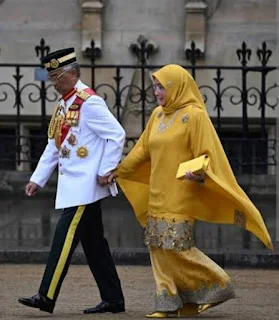 |
| Their Majesties, Sultan Abdullah and Tunku Azizah, at King Charles III's Coronation ©Istana Negara |
But despite gaining independence from Britain, they retained their monarchy, albeit elective and constitutional, and patterned their constitutional monarchy system to Westminster Parliamentary System in the UK.
The monarch or the Yang di-Pertuan Agong is elected by the Conference of Rulers, which is composed of the nine rulers of the Malay states, with the office de facto rotated between them every five years, making Malaysia one of the world's fewest elective monarchies.
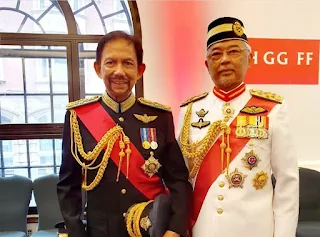 |
| Sultan Hassanal Bolkiah of Brunei and Sultan Abdullah of Pahang and Malaysia ©Istana Negara |
Sultan Abdullah was elected on 24 January 2019, at a special meeting of the Conference of Rulers. He took the oath of office and was sworn in on January 31, 2019.
His wife, Tunku Azizah Aminah Maimunah Iskandariah, is known as Raja Permaisuri Agong or Her Majesty the Queen Consort. They are styled in English as "His Majesty" and "Her Majesty".
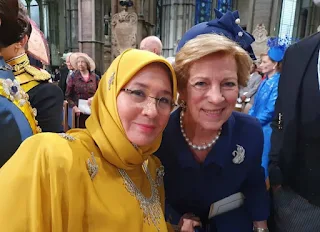 |
| Queen Tunku Azizah and Queen Anne Marie of the former Kingdom of Greece |
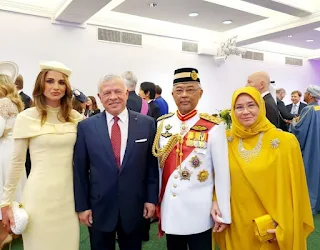 |
| From left Queen Rania and King Abdullah II of Jordan with Malaysian Sultan Abdullah and Queen Tunku Azizah ©Istana Negara |
Their eldest son, Tengku Hassanal Ibrahim, is the Crown Prince of Pahang. Tengku has an equivalent term in English of Prince.
 |
| From left: Tengku Arif Temenggong and his cousin, Crown Prince Hassanal of Pahang, and Prince Abdul Mateen of Brunei at the wedding of Princess Azemah of Brunei |
The Yang di-Pertuan Agong's role is that of a constitutional monarch. The Constitution vests the executive power of the federal government in the monarch.
However, with few exceptions, he is bound to exercise this power on the advice of the Cabinet or a minister acting under the Cabinet's general authority. Thus, in practice, most of the actual day-to-day work of governing is performed by the Cabinet.
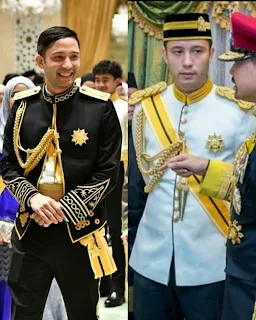 |
| Tengku Arif Temenggong, son of the former Sultan of Pahang. He is the nephew of Sultan Abdullah |
The discretionary powers of the Yang di-Pertuan Agong is purely ceremonial: appointing the Prime Minister, withholding consent to dissolve Parliament, and calling meetings with the Conference of Rulers, and "concerned solely with the privileges, position, honours and dignities of Their Royal Highnesses".
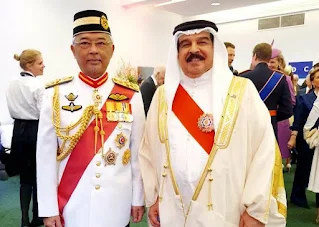 |
| Sultan Abdullah of the Federation States of Malaysia and King Hamad bin Isa Al Khalifa of Bahrain ©Istana Negara |
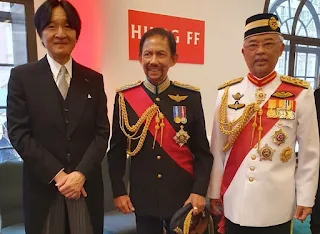 |
| From left Crown Prince Fumihito of Japan, Sultan Hassanal Bolkiah of Brunei, and Sultan Abdullah of Pahang © Istana Negara |


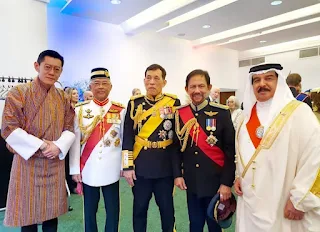





0 Comments